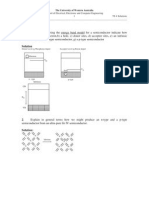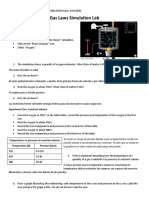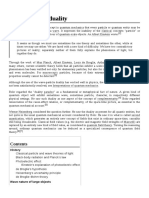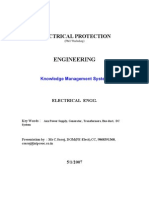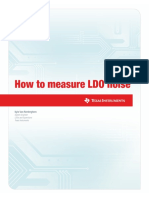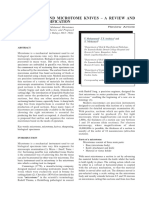Electrical Resistance
Electrical Resistance
Uploaded by
Jaden MoniezCopyright:
Available Formats
Electrical Resistance
Electrical Resistance
Uploaded by
Jaden MoniezOriginal Title
Copyright
Available Formats
Share this document
Did you find this document useful?
Is this content inappropriate?
Copyright:
Available Formats
Electrical Resistance
Electrical Resistance
Uploaded by
Jaden MoniezCopyright:
Available Formats
Electrical Resistance
Any device in a circuit which converts electrical energy into some other form
impedes the current. The device which converts electrical energy to heat energy
is termed a resistor and its ability to impede current is termed resistance. So
resistance can be defined as the opposition to current motion through a
conductor or a device. The material/apparatus that caused this is called a
resistor.
What is a conductor?
- material with low electrical resistance
- electricity can easily flow
- these materials have several loosely bound electrons that can travel through the wire
- Ex. Copper (1.724), silver (1.59), gold (2.44), solder (tin & lead)
Materials that has high electrical resistance and does not permit electricity to flow or
pass
through them are called insulators.
The value of resistance of a conductor depends upon four things;
1. The material from which the conductor is made,
2 The length of the conductor (in the direction of the current path),
3 The thickness (cross-sectional area of the conductor),
4 The temperature at which it operates (in general, the higher its operating temperature
the greater its resistance).
Unit of Resistance - Ohm (Ω)
Resistance is measured in ohms (symbol Ω)). All materials at normal room temperature
have electrical resistance. If the material is classed as a conductor its resistance is
probably much less than 1000 ohms. If the material is classed as an insulator its
resistance
is probably well in excess of 20,000,000 ohms.
The current in a circuit can be changed by changing the value of the supply emf
(electromotive force or voltage) or the value of the resistance. If the supply emf is
increased but the resistance remains the same the current will increase. If the supply
emf
remains the same but the resistance is increased, the current will decrease.
Common Causes of Excessive Current
1. Short-Circuits (for example live wires touching inside equipment or cable)
2. Overloads (for example too many appliances/devices plugged into one socket/outlet).
3. Insulation Faults (for example worn cables to outdoor equipment allow live
conductors
to touch earth, or metal objects touch overhead power lines and earth at the same
time).
Factors affecting resistance of a wire:
1. Length (l) of wire
- the longer the wire, the greater is its resistance
2. Cross-sectional Area (A) of the wire
- the smaller the cross-sectional area the greater is its resistance
3. Material (ρ) of wire (resistivity of the material)
- different materials permit electrons to flow at different capacity
Considering all these factors, we have the equation of resistivity which is expressed
ρl
mathematically as R= where R = resistivity
A
l = length of wire
ρ = resistivity constant of the material
A = cross-sectional area of the wire
You might also like
- Albelda and Orleans - Electricity, Magnetism and ElectronicsNo ratings yetAlbelda and Orleans - Electricity, Magnetism and Electronics30 pages
- Chapter 21 - Magnetic Forces and Fields Cutnell11eNo ratings yetChapter 21 - Magnetic Forces and Fields Cutnell11e49 pages
- Current, Resistance and Electromotive Force PDFNo ratings yetCurrent, Resistance and Electromotive Force PDF15 pages
- The Photoelectric Effect: Summary From Last TimeNo ratings yetThe Photoelectric Effect: Summary From Last Time6 pages
- 25 - Current, Resistance, and Electromotive Force - R K Parida - 2019100% (1)25 - Current, Resistance, and Electromotive Force - R K Parida - 201913 pages
- Lesson - Plan - Sobosobo - CG - Electric FluxNo ratings yetLesson - Plan - Sobosobo - CG - Electric Flux4 pages
- 2 Electrostatic Potential and CapacitanceNo ratings yet2 Electrostatic Potential and Capacitance41 pages
- 002 - Option A Chapter 13 Relativity PDFNo ratings yet002 - Option A Chapter 13 Relativity PDF63 pages
- Lesson Plan PhysicsIA Kinematics Graphical Analysis of Motion 2008 Term1No ratings yetLesson Plan PhysicsIA Kinematics Graphical Analysis of Motion 2008 Term12 pages
- Experiment 8 Series and Parallel Circuits Physics LabNo ratings yetExperiment 8 Series and Parallel Circuits Physics Lab7 pages
- Physics IV Lab Worksheet Winter-Spring 2022-2: Capacitors Name: Group#No ratings yetPhysics IV Lab Worksheet Winter-Spring 2022-2: Capacitors Name: Group#11 pages
- Gas Laws Simulation Lab: Experiment One: Constant Volume100% (1)Gas Laws Simulation Lab: Experiment One: Constant Volume4 pages
- Conservative and Non Conservative Forces, Conservation of EnergyNo ratings yetConservative and Non Conservative Forces, Conservation of Energy22 pages
- Chemical Bonding (Engineering Chemistry Lecture)No ratings yetChemical Bonding (Engineering Chemistry Lecture)13 pages
- Chapter 28 Atomic Physics: The Hydrogen Atom The Bohr Model Electron Waves in The AtomNo ratings yetChapter 28 Atomic Physics: The Hydrogen Atom The Bohr Model Electron Waves in The Atom64 pages
- GEN-PHYSICS-2 USLeM WEEK-6 ALLAS VERSION-4No ratings yetGEN-PHYSICS-2 USLeM WEEK-6 ALLAS VERSION-410 pages
- 3 - 1 Magnetic Effect of A Current-Carrying Conductor100% (1)3 - 1 Magnetic Effect of A Current-Carrying Conductor3 pages
- Light Amplification by Stimulated Emission of RadiationNo ratings yetLight Amplification by Stimulated Emission of Radiation46 pages
- Lesson Plan - Antennas & Wave Propagation (15EC604)100% (1)Lesson Plan - Antennas & Wave Propagation (15EC604)25 pages
- Electrostatics Questions Energy and Work With AnswersNo ratings yetElectrostatics Questions Energy and Work With Answers14 pages
- PhET - Energy Forms & Changes Virtual LabNo ratings yetPhET - Energy Forms & Changes Virtual Lab4 pages
- LAB ACTIVITY NO 2 Understanding Measurements SI Units and Density ES 1No ratings yetLAB ACTIVITY NO 2 Understanding Measurements SI Units and Density ES 12 pages
- Activity 1:: Faraday's Law of Electromagnetic Induction and Lenz's LawNo ratings yetActivity 1:: Faraday's Law of Electromagnetic Induction and Lenz's Law2 pages
- Renewable & Non - Renewable Energy ResourcesNo ratings yetRenewable & Non - Renewable Energy Resources53 pages
- Electric Potential and E-Fields PhET Hypothesis Lab PDFNo ratings yetElectric Potential and E-Fields PhET Hypothesis Lab PDF3 pages
- Kirchhoff's Current Law: - (Incoming Currents) = Σ (Outing Currents)No ratings yetKirchhoff's Current Law: - (Incoming Currents) = Σ (Outing Currents)16 pages
- RESISTIVITY and CONDUCTIVITY of MaterialsNo ratings yetRESISTIVITY and CONDUCTIVITY of Materials22 pages
- Electric Conduction and Resistance PresentationNo ratings yetElectric Conduction and Resistance Presentation20 pages
- Series - Wound DC Generator: The Magnetic Field of The SeriesNo ratings yetSeries - Wound DC Generator: The Magnetic Field of The Series3 pages
- Preventive and Protective Measures, Ppe: Assessment and Risk Control ProcessNo ratings yetPreventive and Protective Measures, Ppe: Assessment and Risk Control Process3 pages
- Wave Nature of Light: Basic Properties of Waves: Amplitude, Wavelength, and FrequencyNo ratings yetWave Nature of Light: Basic Properties of Waves: Amplitude, Wavelength, and Frequency4 pages
- 4.3 Euler's Method: Linear ApproximationNo ratings yet4.3 Euler's Method: Linear Approximation4 pages
- "Our Greatest Possession Is The Right To: Words To Ponder Upon (5-9 AUGUST 2019)0% (1)"Our Greatest Possession Is The Right To: Words To Ponder Upon (5-9 AUGUST 2019)1 page
- AP Set Physical Sciences Question Papers of July 2012 and Keys PDF100% (1)AP Set Physical Sciences Question Papers of July 2012 and Keys PDF51 pages
- 20 Watt Class A Power Amplifier Circuit - Electronic CircuitNo ratings yet20 Watt Class A Power Amplifier Circuit - Electronic Circuit5 pages
- Design For Testability: N.Pitcheswara Rao Assistant Professor ECE DepartmentNo ratings yetDesign For Testability: N.Pitcheswara Rao Assistant Professor ECE Department47 pages
- Bidirectional Visitor Counter With Security System and Automated Room Light ControllerNo ratings yetBidirectional Visitor Counter With Security System and Automated Room Light Controller4 pages
- N-Channel Enhancement Mode MOSFET: Product SummaryNo ratings yetN-Channel Enhancement Mode MOSFET: Product Summary5 pages
- Circuit Activity Based Logic Synthesis For Low Power Reliable OperationsNo ratings yetCircuit Activity Based Logic Synthesis For Low Power Reliable Operations11 pages
- Microtomes and Microtome Knives - A Review andNo ratings yetMicrotomes and Microtome Knives - A Review and8 pages








